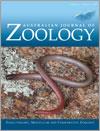Transport and processing of allochthonous material is crucial for trophic pathways in headwater streams. Freshwater crayfish are known to affect and exploit the break-down of in-stream terrestrial plant material into detritus. We recorded Euastacus armatus (Murray River crayfish) individuals feeding on discrete patches of allochthonous material within an unregulated section of the Goodradigbee River, an upland stream in temperate Australia. Despite suggestions of aggressive territoriality, E. armatus were observed by remote and manual underwater filming to feed in non-aggressive aggregations on these piles of fine woody debris and leaf litter. On the basis of observations of 25 individuals found in the vicinity of the allochthonous patches, this population comprised mostly female individuals at smaller sizes of maturity than has been recorded for lowland populations of E. armatus. Our study confirms the importance of concentrated allochthonous food patches for detritivores, and points to the important trophic linkage between terrestrial and aquatic ecosystems via a widespread and iconic freshwater invertebrate. Moreover, these non-aggressive feeding aggregations of E. armatus challenge notions of aggression in this species that have been developed in small-scale aquarium studies.
How to translate text using browser tools
28 April 2015
Ceasefire: minimal aggression among Murray River crayfish feeding upon patches of allochthonous material
Danswell Starrs,
Brendan C. Ebner,
Christopher J. Fulton
ACCESS THE FULL ARTICLE

Australian Journal of Zoology
Vol. 63 • No. 2
May 2015
Vol. 63 • No. 2
May 2015
aggression
communal feeding
detritivory
eddies
flow
underwater video




